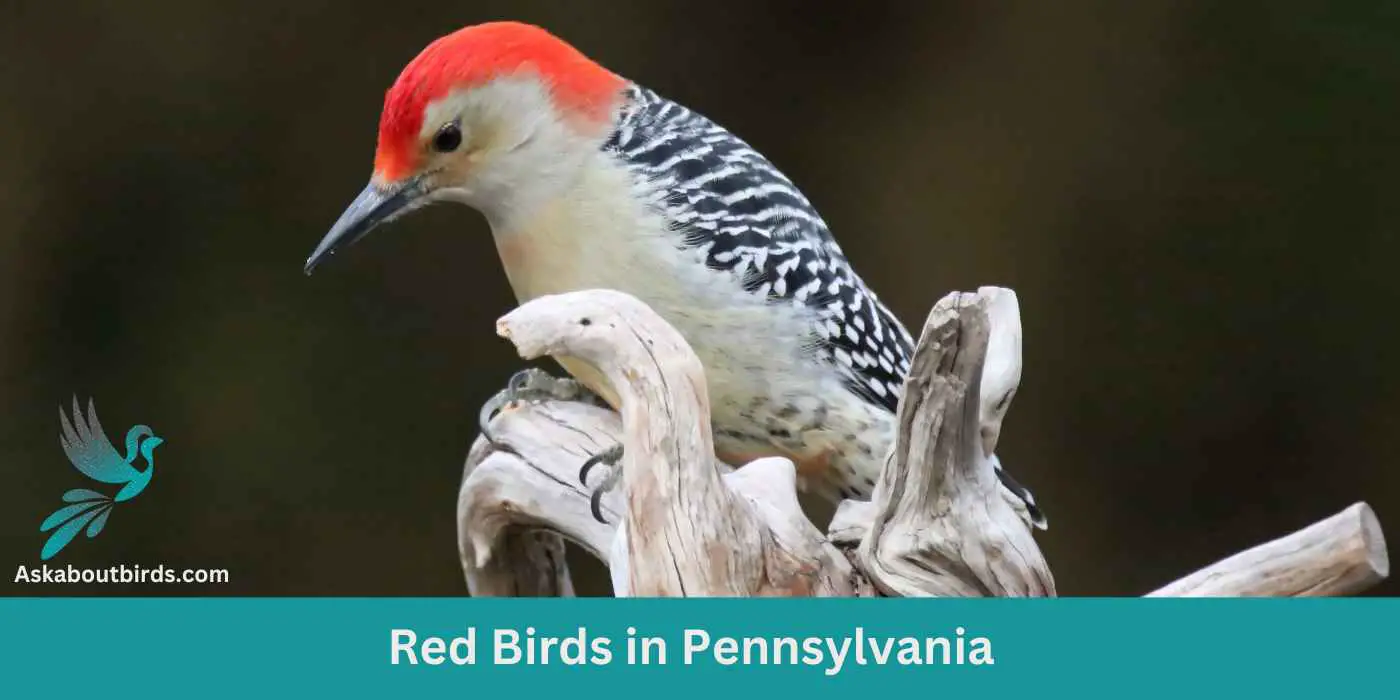From the rolling hills of the Appalachians to the bustling streets of Philadelphia, Pennsylvania is home to a variety of habitats that play host to an array of vibrant avian species.
Among these winged wonders, 11 distinct red birds stand out, adding a splash of color to the Keystone State’s diverse landscapes.
Dive deep into our guide to meet these crimson-feathered residents and enhance your birdwatching journey with our complimentary photo guide.
Red Birds Found In Pennsylvania
Blessed with the ridges of the Appalachian Mountains, expansive hardwood forests, and an array of wetlands, Pennsylvania provides a myriad of habitats suitable for a wide range of bird species.
The state’s geographical location serves as a critical waypoint for many migratory birds, while its varied topography and climatic conditions foster diverse ecological niches.
Northern Cardinal


| Feature | Measurement |
|---|---|
| Scientific Name | Cardinalis cardinalis |
| Length | 8.3 – 9.1 in |
| Wingspan | 9.8 – 12.2 in |
| Weight | 1.19 – 2.29 oz |
The Northern Cardinal is an iconic North American bird, easily recognized by its vibrant color and melodious song.
Appearance: Male Northern Cardinals are a brilliant scarlet red, while females display a more subdued reddish olive. Both sexes have a distinctive black ‘mask’ on their face around the bill and a pointed crest on their head. The bird’s beak is robust, cone-shaped, and bright orange in color.
Diet: Northern Cardinals are primarily granivorous, with a diet largely consisting of seeds and grains. They also eat fruits and insects. These birds typically feed off the ground and are frequent visitors to bird feeders.
Reproduction: Northern Cardinals are monogamous, and a pair will breed together for life. The female typically builds a well-hidden nest in a dense thicket or shrub. She lays 2-5 eggs per clutch, which she incubates for around two weeks.
Summer Tanager


| Feature | Measurement |
|---|---|
| Scientific Name | Piranga rubra |
| Length | 6.7 in |
| Wingspan | 28 to 30 cm |
| Weight | 29 g |
The Summer Tanager is a medium-sized songbird admired for its radiant plumage and melodious song.
Appearance: Male Summer Tanagers are an impressive bright red, while females and juveniles present a softer, yellow-orange color. Both genders have a large, slightly hooked bill and relatively short tail.
Diet: Summer Tanagers primarily feed on insects, including bees and wasps, which they catch in flight or pick off vegetation. They are also known to eat fruits and berries, making them helpful in controlling pest populations and seed dispersal.
Reproduction: The female Summer Tanager builds a loose, shallow cup-shaped nest out of twigs and grass, usually hidden in the foliage of trees. The female typically lays 3-5 eggs, which she will incubate for about two weeks.
Scarlet Tanager


| Feature | Measurement |
|---|---|
| Scientific Name | Piranga olivacea |
| Length | 6.3 to 7.5 in |
| Wingspan | 9.8 to 11.8 in |
| Weight | 23.5 to 38 g |
The Scarlet Tanager is a strikingly colorful bird known for its brilliant plumage and distinctive song.
Appearance: Male Scarlet Tanagers are notable for their vibrant scarlet bodies contrasted with black wings and tail, making them one of the most intensely colored birds. Females and juveniles, on the other hand, have a subdued olive-yellow body color with darker wings and tail.
Diet: The diet of the Scarlet Tanager is largely made up of insects, including beetles, cicadas, aphids, and others. They are adept flycatchers, seizing insects in mid-air or picking them off foliage. They also consume fruits and berries, especially during migration and in their winter habitats.
Reproduction: The female Scarlet Tanager builds a cup-shaped nest using twigs, rootlets, and grass, typically well-hidden in the dense foliage of trees. She lays 3 to 5 eggs and incubates them for about two weeks.
House Finch


| Feature | Measurement |
|---|---|
| Scientific Name | Haemorhous mexicanus |
| Length | 5–6 in |
| Wingspan | 8–10 in |
| Weight | 0.6–0.9 oz |
The House Finch is a small songbird widely distributed across North America and is commonly found in urban and suburban areas.
Appearance: Males of this species are brightly colored with crimson faces and throats, which can extend to the chest and back, while their flanks have streaks. The female is streaked brown and lacks the red coloring. Both have a square-tipped tail and a distinctively long, flat-topped bill.
Diet: House Finches primarily eat seeds, grains, and berries. They have a particular fondness for sunflower seeds and can be commonly seen at bird feeders. Occasionally, they will also consume insects, especially during the breeding season.
Reproduction: House Finches are cavity-nesters and might choose ledges, vents, ledges, and other urban settings. They might also utilize trees or shrubs. Their nests can be made of a wide array of materials, from feathers to twigs.
Purple Finch


| Feature | Measurement |
|---|---|
| Scientific Name | Haemorhous purpureus |
| Length | 4.7–6.3 in |
| Wingspan | 4.7–6.3 in |
| Weight | 0.6–1.1 oz |
The Purple Finch is a vibrant songbird often mistaken for its close relative, the House Finch, but it exhibits a different hue and patterns.
Appearance: Males are raspberry red on the head, throat, and breast, with streaky brown backs and wings. The intensity of the red can vary among individuals. Females are brown and streaked all over but might show a slight blush on the face. They lack the strong facial patterns seen in female House Finches.
Diet: Purple Finches primarily consume seeds, with a preference for sunflower seeds, dandelion seeds, and buds. They also eat insects and berries, especially during the breeding season.
Reproduction: These finches often nest in conifers or mixed woodlands. The nest, typically located on a horizontal branch, is made from twigs and grass, then lined with feathers.
Red Crossbill

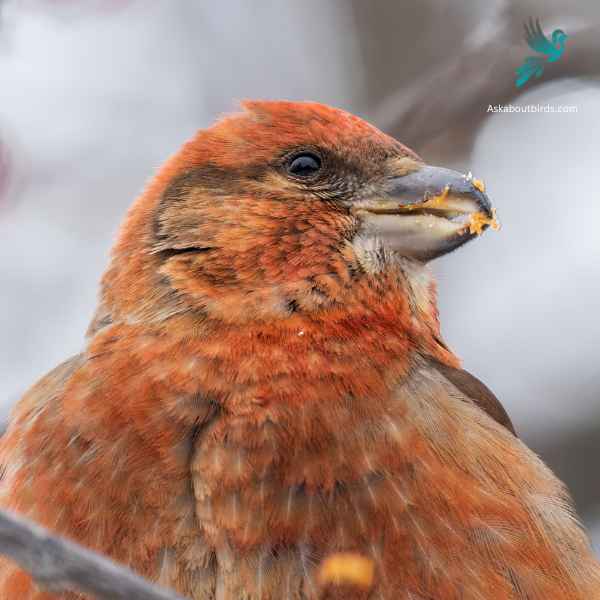
| Feature | Measurement |
|---|---|
| Scientific Name | Loxia curvirostra |
| Length | 5.5–7.5 in |
| Wingspan | 9.8–10.6 in |
| Weight | 0.9–1.4 oz |
The Red Crossbill is a distinctive finch known for its unusual bill, which has evolved to extract seeds from conifer cones.
Appearance: Males are typically bright red or orange, while females are greenish-yellow or olive. Both genders have the characteristic crossed bill, which they use to expertly extract seeds from tightly closed conifer cones.
Diet: Red Crossbills primarily feed on the seeds of coniferous trees, such as spruce, pine, and fir. Their specialized bills allow them to efficiently pry apart conifer cone scales to access the seeds.
Reproduction: Red Crossbills are somewhat nomadic and don’t adhere to a strict breeding schedule. Instead, they breed whenever and wherever food is abundant. Their nests are usually built on horizontal branches of conifer trees.
Red-bellied Woodpecker
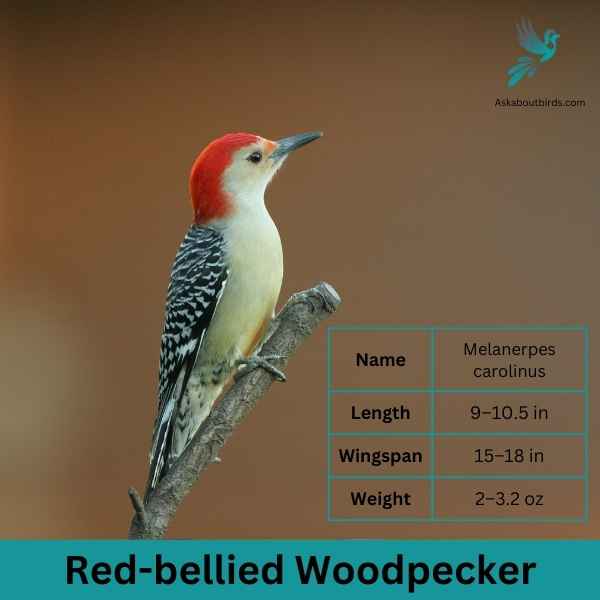
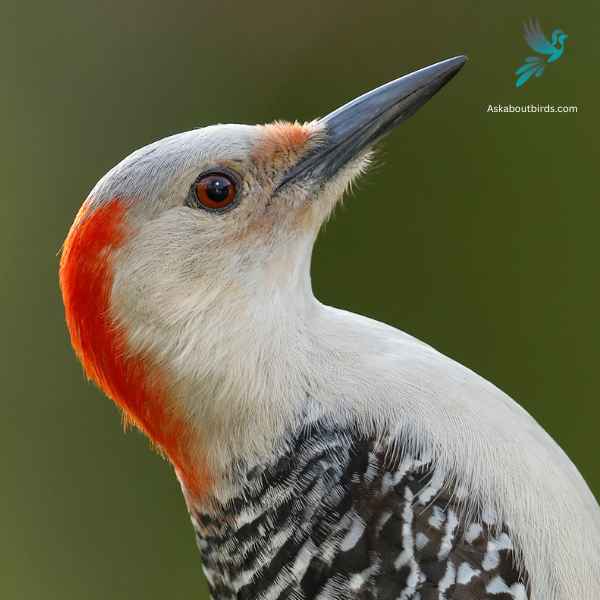
| Feature | Measurement |
|---|---|
| Scientific Name | Thryothorus ludovicianus |
| Length | 4.7–5.5 in |
| Wingspan | 11 in |
| Weight | 0.63–0.81 oz |
The Red-bellied Woodpecker is a medium-sized woodpecker commonly found in woodlands, forests, and backyards across the eastern and central U.S.
Appearance: The Red-bellied Woodpecker sports a pale gray face, throat, and belly, contrasted by a zebra-striped back. Its name derives from the subtle reddish tinge on its belly, but it’s more commonly recognized by the vivid red cap on the head of males and the partial red cap on females.
Diet: This woodpecker has a varied diet that includes insects, fruits, nuts, and seeds. They frequently forage on tree trunks and branches, using their sticky, barbed-tipped tongue to extract ants, beetles, and other insects from crevices.
Reproduction: Red-bellied Woodpeckers are cavity nesters, excavating holes in tree trunks for their nests. The inside of the nest is typically unlined or sparingly lined with wood chips.
Red-headed Woodpecker

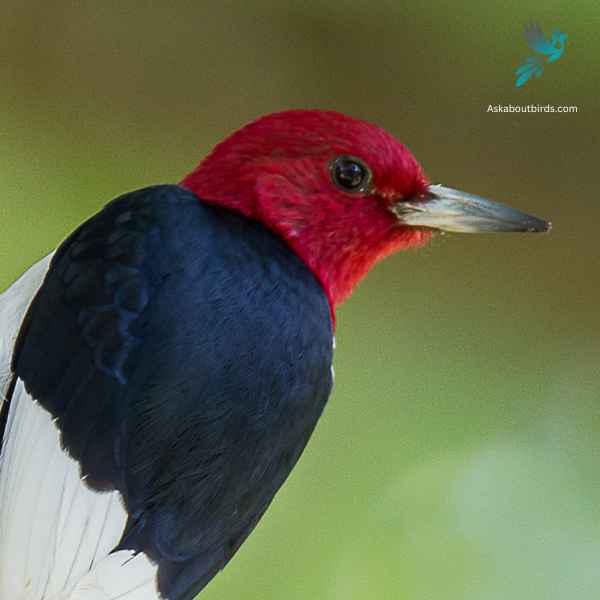
| Feature | Measurement |
|---|---|
| Scientific Name | Melanerpes erythrocephalus |
| Length | 7.5–9.1 in |
| Wingspan | 16.5 in |
| Weight | 2.0–3.2 oz |
The Red-headed Woodpecker is a striking forest bird with a bold tri-colored pattern.
Appearance: This woodpecker features a completely red head and neck, contrasting starkly with its white underparts and black wings. Its wings also have large white patches which are conspicuous in flight.
Diet: Red-headed Woodpeckers have a varied diet including insects, seeds, fruits, berries, and occasionally even the eggs of other birds. They’re also known to store food by wedging it into crevices in bark.
Reproduction: These woodpeckers nest in cavities which they excavate in dead wood or dead parts of live trees. These cavities can be found anywhere from 2 to 80 feet off the ground.
Pine Grosbeak

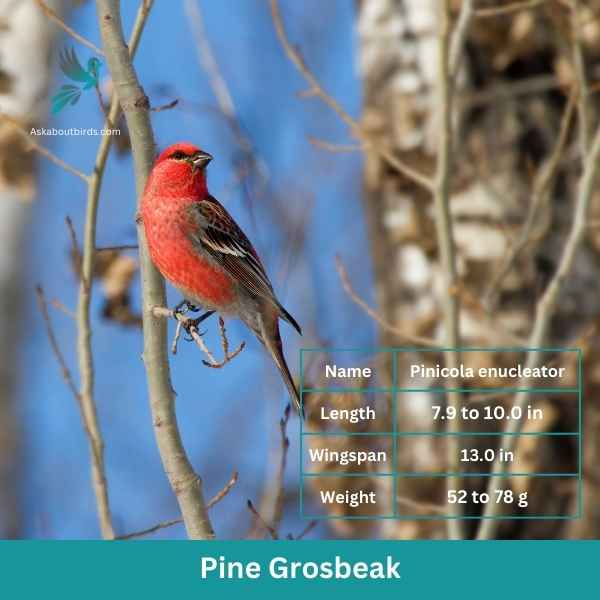
| Feature | Measurement |
|---|---|
| Scientific Name | Pinicola enucleator |
| Length | 7.9 to 10.0 in |
| Wingspan | 13.0 in |
| Weight | 52 to 78 g |
The Pine Grosbeak is a striking bird native to the northern regions of North America, often found in coniferous forests. Both males and females have a plump and robust body with a large beak adapted for eating seeds. The male Pine Grosbeak displays a vibrant reddish-pink plumage, while the female has a more subdued grayish-brown coloration.
These birds are typically seen in small flocks, foraging for food in trees and on the ground. They have a preference for seeds, particularly those from various conifer species. The Pine Grosbeak uses its strong bill to crack open the cones of tall trees and extract the seeds, but they also consume berries and small fruits when available.
Common Redpoll

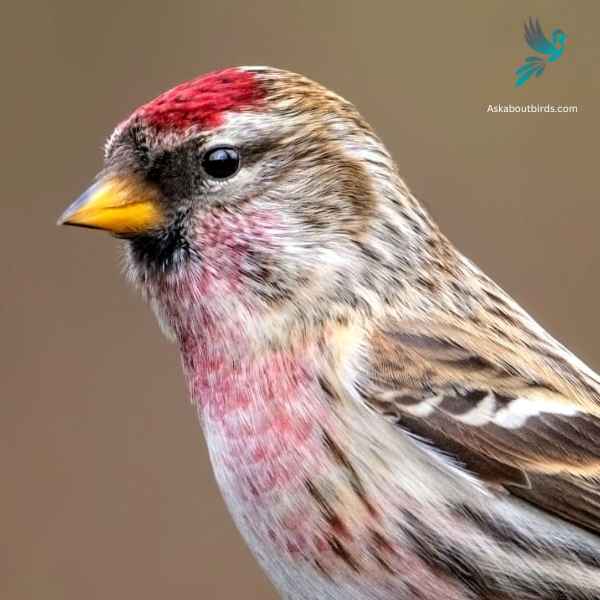
| Feature | Measurement |
|---|---|
| Scientific Name | Acanthis flammea |
| Length | 5.0-5.5 in |
| Wingspan | 7.5-8.5 in |
| Weight | 0.4-0.9 oz |
The Common Redpoll is a small songbird that is easily identifiable by its rosy-red forehead, black chin, and often fluttering flight pattern.
Appearance: Common Redpolls exhibit a distinctive rosy-red forehead patch and black chin. The males typically have a more extensive pink wash on their chest and face than females. The rest of their body is primarily streaked brown and white, with two white wing bars and a notched tail.
Diet: The diet of the Common Redpoll predominantly consists of seeds, particularly from birches and alders. They have a specialized throat pouch where they can temporarily store seeds, allowing them to consume them later in a more sheltered location.
Reproduction: Common Redpolls nest in shrubs or on the ground, using grasses, twigs, and feathers for construction. The female is responsible for the majority of the incubation and typically lays a clutch of 4 to 6 eggs. After the eggs hatch, both parents take part in feeding the young.
Red-Winged Blackbird
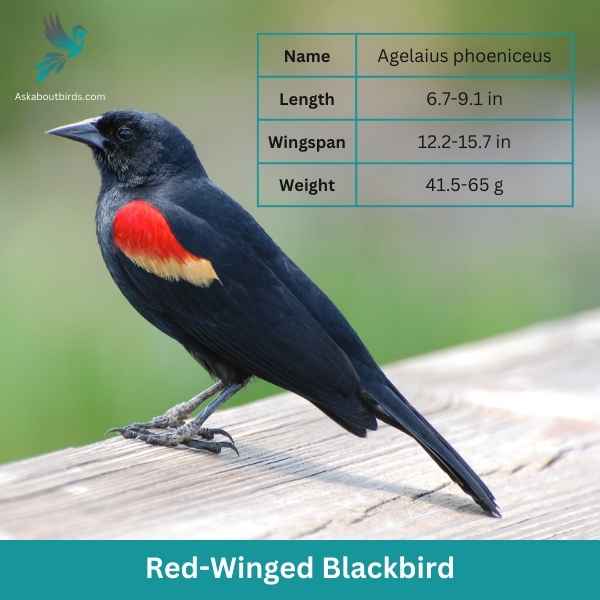
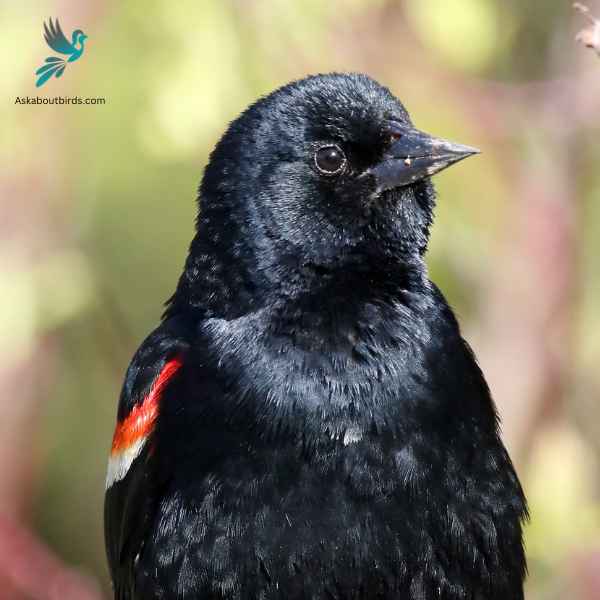
| Feature | Measurement |
|---|---|
| Scientific Name | Agelaius phoeniceus |
| Length | 6.7-9.1 in |
| Wingspan | 12.2-15.7 in |
| Weight | 41.5-65 g |
The Red-Winged Blackbird is a familiar sight across North America, especially in wetlands and open areas. Known for its striking coloration and distinct call, it is often seen perched on cattails or utility lines.
Appearance: Male Red-Winged Blackbirds are glossy black with bright red-and-yellow shoulder patches, while females are streaky brown, resembling a large sparrow. The males’ red patches become more prominent when they’re displaying or agitated.
Diet: Red-Winged Blackbirds primarily feed on seeds and insects. Their diet includes grains, sunflower seeds, and corn, but they also eat beetles, caterpillars, and other small invertebrates, especially in the breeding season.
Reproduction: Red-Winged Blackbirds nest in marshes, along watercourses, and in wet fields. The female constructs a cup-shaped nest using grass and sedge, attaching it to plants above water. She typically lays a clutch of 3 to 4 blue-green eggs, which she incubates for about 11-12 days. Males, being polygynous, often have multiple mates during a single breeding season.
Where to Spot Pennsylvania’s Red Birds
From its wooded mountain ridges to its serene wetlands, Pennsylvania offers bird enthusiasts a plethora of prime viewing locales. Here are the top spots known for their avian diversity:
- Hawk Mountain Sanctuary, Kempton: One of the best places in North America for watching raptor migration, Hawk Mountain provides breathtaking views and encounters with various hawk species, eagles, and falcons.
- Middle Creek Wildlife Management Area, Stevens: A critical stopover for migrating waterfowl, Middle Creek is also home to a variety of songbirds, raptors, and shorebirds, making it a birdwatcher’s paradise in all seasons.
- Presque Isle State Park, Erie: Nestled on Lake Erie, this park is a magnet for migratory birds. With over 320 species recorded, it offers diverse habitats from beaches to marshlands, attracting rarities and providing fantastic birding opportunities.
- Conneaut Marsh, Crawford County: One of the state’s largest natural wetlands, Conneaut Marsh is a hotspot for marsh birds, waterfowl, and songbirds, offering an unrivaled birding experience in a pristine environment.
- John Heinz National Wildlife Refuge at Tinicum, Philadelphia: Located near the urban heart of Philadelphia, this refuge serves as a green oasis for more than 300 bird species, making it an excellent spot for spotting both migratory and resident birds.
| State’s Red Birds | Top Spots for Red Birds |
|---|---|
| New York’s Red birds | 1. Montezuma National Wildlife Refuge 2. Central Park, New York City 3. Bashakill Wildlife Management Area |
| New Jersey’s Red birds | 1. Cape May Point State Park 2. The Celery Farm, Allendale 3. Great Swamp National Wildlife Refuge |
| Delaware’s Red birds | 1. Bombay Hook National Wildlife Refuge 2. Cape Henlopen State Park |
| Maryland’s Red birds | 1. Blackwater National Wildlife Refuge 2. Catoctin Mountain Park 3. Assateague Island |
| West Virginia’s Red birds | 1. Canaan Valley National Wildlife Refuge 2. New River Gorge National Park and Preserve |
| Ohio’s Red birds | 1. Magee Marsh Wildlife Area 2. Cuyahoga Valley National Park 3. Shawnee State Forest |
FAQs on Red Bird Species Found in Pennsylvania
What are the distinct features of the white-winged crossbill?
The white-winged crossbill, a member of the finch family, is renowned for its unique adaptations and bright plumage. Native to the northern and western states, they stand out with their prominent tail feathers and an iconic reddish-purple head. These medium-sized birds are particularly recognized for the white markings on their wings, which differentiate them from other birds. They primarily feed on conifer seeds, which they adeptly extract from pinecones, making them a fascinating sight for birdwatchers in forest canopies.
How does the painted bunting differ from other colorful birds in central and south America?
The painted bunting, with its bright blue heads and vivid green wings, is a captivating spectacle among the birds of central and south America. This beautiful bird, often seen in dense vegetation and forest edges, boasts a combination of bright red plumage and yellow feathers, making it distinct from its avian counterparts. While they are shy birds are most active during the winter months, they are a year-round delight for enthusiasts, especially when they visit bird feeders. Their striking appearance and shy nature set them apart as one of the most sought-after sightings for bird lovers.
What characterizes the rose-breasted grosbeak in the eastern United States?
The rose-breasted grosbeak is a medium-sized bird celebrated for its remarkable appearance, primarily its scarlet red chest, which contrasts vividly with its brown plumage. Native to the eastern United States, these birds can be commonly sighted in deciduous forests and backyard bird feeders. The male, with its bright red head, and the female birds, displaying dull orange heads, exhibit varied color patterns. Apart from their striking appearance, their diet consists of both flying insects and black oil sunflower seeds, making them a versatile feeder in the bird world.
What makes the scarlet tanager a standout among the birds in deciduous forests?
The scarlet tanager is the epitome of brilliant avian beauty. With its bright red plumage, contrasted by jet-black wings, this bird is undeniably a sight to behold in deciduous forests of the southern and eastern states. While the male boasts a radiant red body, female scarlet tanagers wear a more subdued greenish-yellow coat. Their diet, predominantly comprising flying insects and fruits, often draws them to backyard feeders. Bird enthusiasts and casual viewers alike consider them a treasured find, given their vibrant coloration and melodious calls, truly making them a standout in the avian world.

